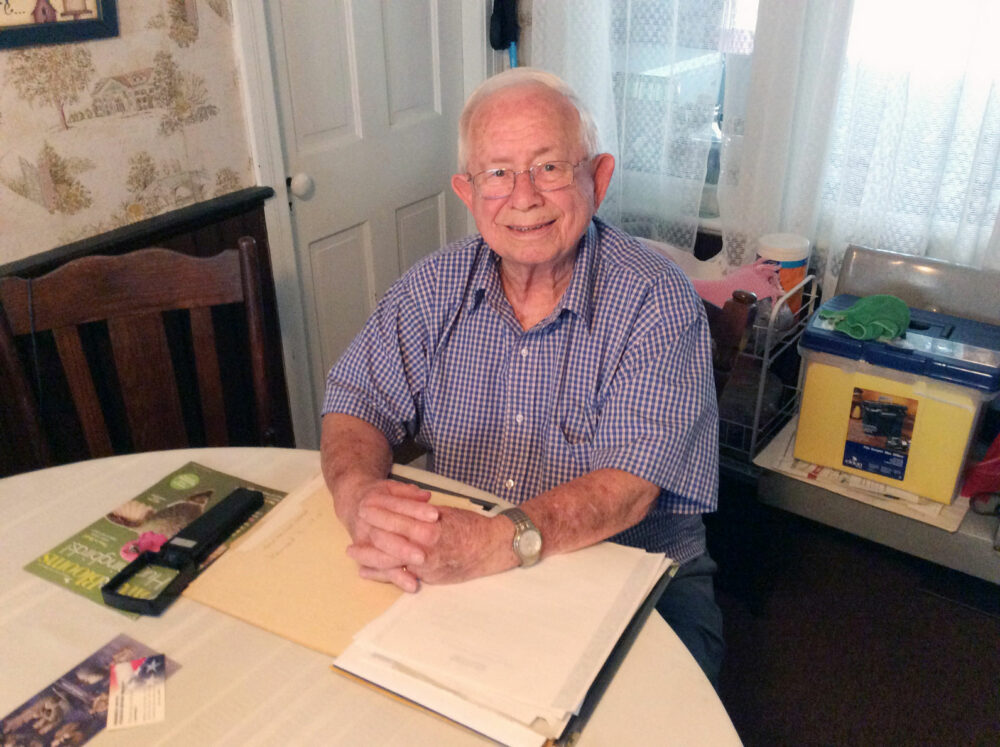
Although Edward Bowman Coleman was born in Port Republic, Virginia, in 1924, he has lived most of his life in the Blue Ridge Summit and Sabillasville areas.
In the early 1920s, his father rented a farm in Virginia, earning $1.00 a month, two hogs, and a house to live in. Later, the family moved north and rented farms that the banks had foreclosed on during the hard times of the Great Depression. When the farm was sold, the Colemans moved on to another foreclosed farm. Once the Colemans lived next to the Browns, the mothers would do their Monday laundry together because Edward’s mother had a gas-powered washer! Edward did not notice at the time the Bowman’s 13-year-old daughter….but he would later!
Edward’s father worked at the Crown, Cork and Seal Co. until he broke his leg, resulting in one leg being shorter than the other. His father then moved to Baltimore to work at the Martin Marietta Plant and would return home to Sabillasville on the weekends. Edward attended the brick school at Sabillasville through seventh grade, and then went on to Thurmont High School, where he graduated in 1942.
Edward followed his father to Baltimore to work at Martin Marietta as well, but with war engulfing the entire world, the U.S. Army drafted Edward in February 1943. After training, he was assigned to Company A, 149th Infantry, 38th Division, nick-named the Cyclone Division. In January 1944, the division shipped out as part of a large convoy that traveled through the Panama Canal on its way to Hawaii. The wrecks of the ships the Japanese sunk on December 7, 1941, were still visible, and his company patrolled the beaches until they were sent to New Guinea for “mopping up” operations. Luckily, they did not encounter any enemy troops, but Edward did notice that the native women did not wear bras!
Then they traveled to the Philippine Island of Leyte, where the American troops first invaded the island nation. Ironically, Leyte is where a Japanese sniper severely injured Graceham native, Sterling Seiss. Before Edward arrived, they encountered a bizarre quirk of nature: a fine white powder that reduced visibility to zero suddenly engulfed their ship. Without warning, their ship beached on a coral outcropping just beneath the sea with no land in sight! Unable to get the ship off the coral, the troops boarded other smaller landing crafts. They eventually discovered a volcanic eruption miles away that caused the white cloud.
Once again, Edward’s company performed “mopping up” operations. The enemy had abandoned a strategic landing strip, and Edward’s company was there to protect it. Edward and a comrade dug a foxhole and two slit trenches to rest in while another soldier kept guard. They switched jobs every two hours. Edward had just finished his duty and was trying to get a little rest when a grenade exploded right in front of his buddy, killing him instantly. In the battle that followed, Japanese paratroopers attempted to regain the airstrips. They failed, but the Japanese killed 18 men in Edward’s company.
With Leyte finally secure, the 149th was loaded up and sent to Subic Bay in Luzon. Manila had finally fallen, and 100,000 Filipinos died in the horrific fighting there. Gen. Douglas MacArthur then declared the Philippines secure, neglecting to mention the thousands of enemy troops still in the mountainous north. Once more, Edward’s regiment was sent to “mop up” northern Luzon. They were still fighting when the Japanese surrendered after the bombing of Hiroshima and Nagasaki. Because of their battles on the Bataan peninsula, they are called the Avengers of Bataan.
After spending nearly two years abroad, Coleman was finally discharged in November 1945, having earned the Combat Infantryman’s Badge, the Good Conduct Medal, and the Philippine Liberation Ribbon with one Bronze Star. He returned home to meet his youngest sibling, a sister, born when he was in the Pacific.
Jobs were hard to come by after the War, and Edward worked at Fairchild in Hagerstown and at Martin Marietta. Then, using the GI Bill, he attended an aeronautic mechanic’s school. Martin Marietta rehired him, and he spent the rest of his career with the company, even moving to Orlando, Florida, in order to keep his job.
In 1949, he married the now-grown-up Doris Brown, whom he had met so long ago. They had three daughters: Denise, Donna, and Darlene.
When Edward’s father died, Edward bought his house in Sabillasville, where he now spends the summer enjoying the peace of the Catoctin Mountains. However, when the cool winds begin to blow, the family returns to their home in Orlando. In good health, Edward enjoys the mountains and still gardens with the help of his nephew. He revels in the love of his family that now includes four grandchildren.
If you are a Veteran or know a Veteran who is willing to tell his or her story, contact the Frederick County Veterans History Project at priscillarall@gmail.com.

